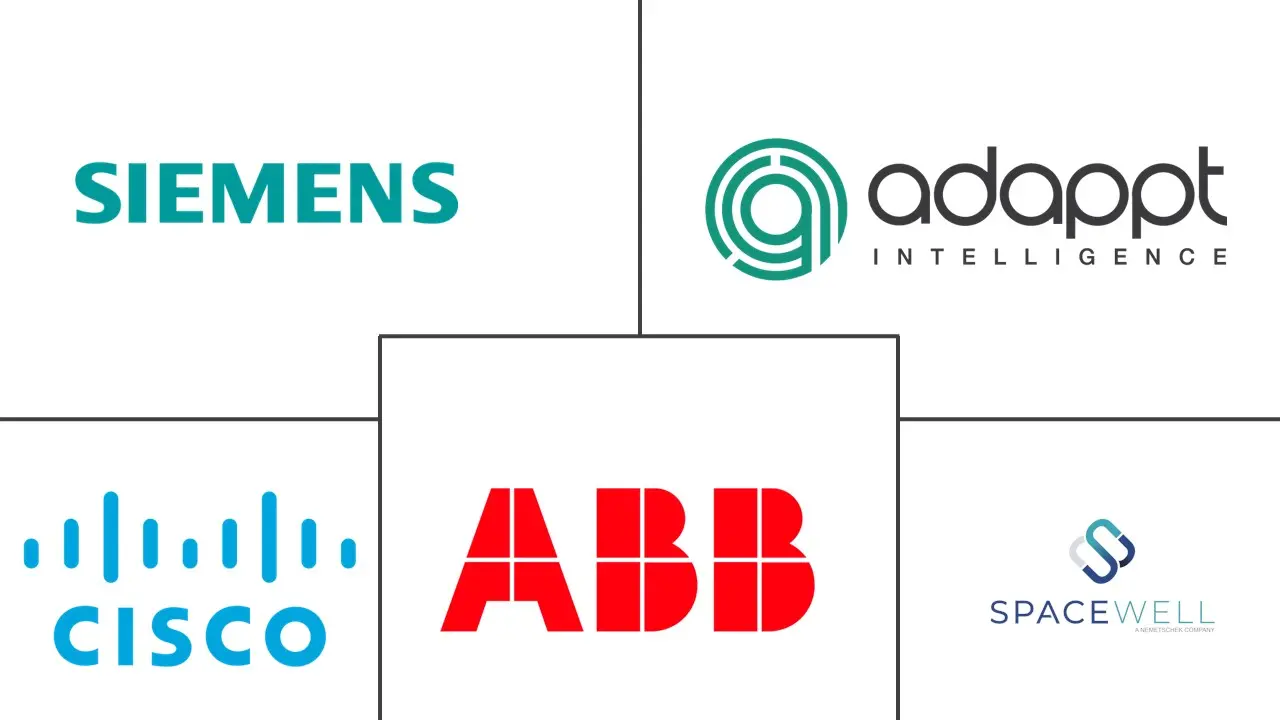Smart Spaces Market Size and Share
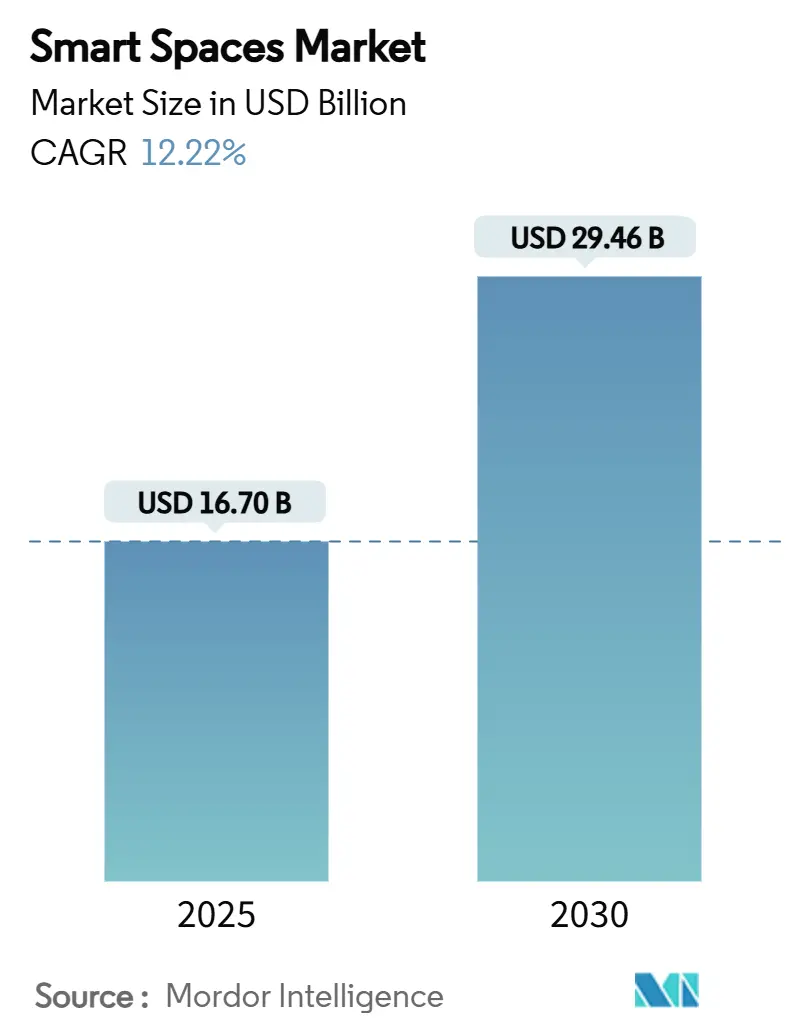
Smart Spaces Market Analysis by Mordor Intelligence
The Smart spaces market size stood at USD 16.70 billion in 2025 and is forecast to expand at a 12.22% CAGR, reaching USD 29.46 billion by 2030.[1]Thread Group, “Thread 1.4 Product Certifications Pass 670 Milestone,” threadgroup.org The upward trajectory is shaped by falling IoT sensor prices that simplify large-scale deployment, mandatory net-zero building codes that accelerate digital retrofits, and hybrid-work policies that reward real-time space optimisation. Interoperable standards such as Thread 1.4, certified on more than 670 products by Q1 2025, remove integration risks and shorten payback windows. Private 5G rollouts across commercial campuses underpin advanced analytics that lower utilities and maintenance costs while enabling predictive workplace services. Vendors are also scaling software-as-a-service models that bundle continuous optimisation with outcome-based pricing, a shift that converts one-time capital expenditure into recurring revenue. The Smart space market, therefore, benefits from both top-line demand for compliance and bottom-line demand for efficiency.
Key Report Takeaways
- By type, Solutions captured 68% of the Smart spaces market share in 2024, whereas Services are projected to expand at a 13.87% CAGR through 2030.
- By end-user industry, the commercial segment led with 59% revenue in 2024; residential deployments are forecast to advance at a 13.75% CAGR to 2030.
- By application, Energy Management accounted for 34% of the Smart space market size in 2024, while Occupancy and Space Analytics are projected to grow at a 12.67% CAGR.
- By connectivity, Wi-Fi held 48% of 2024 revenue; Thread/Matter networks are expected to rise at a 13.05% CAGR over the forecast period.
- By geography, North America commanded 37% of 2024 revenue, yet, Asia Pacific is on track for a 13.53% CAGR through 2030.
Global Smart Spaces Market Trends and Insights
Drivers Impact Analysis
| Driver | (~) % Impact on CAGR Forecast | Geographic Relevance | Impact Timeline |
|---|---|---|---|
| IoT-enabled device proliferation and falling sensor prices | +2.8% | Global, APAC leads volume deployment | Medium term (2-4 years) |
| Accelerated hybrid-work redesign of offices | +2.1% | North America and EU core markets | Short term (≤2 years) |
| Mandatory green-building / net-zero regulations | +1.9% | EU, California, select APAC markets | Long term (≥4 years) |
| AI-driven workplace analytics reducing real-estate OPEX | +1.7% | Global, concentrated in Tier-1 cities | Short term (≤2 years) |
| Rapid 5G private-network roll-outs in commercial estates | +1.4% | North America, EU, Japan, South Korea | Medium term (2-4 years) |
| Rise of occupancy-based insurance and leasing models | +1.3% | North America, select EU markets | Long term (≥4 years) |
| Source: Mordor Intelligence | |||
IoT-enabled device proliferation and falling sensor prices
Semiconductor oversupply has pushed sensor average selling prices down by double-digits since 2023, allowing building owners to blanket properties with occupancy, air-quality and power-meter nodes that feed granular data to cloud analytics. More than 670 Thread-certified devices shipped by early 2025, a clear signal that vendors now view multi-vendor interoperability as table stakes. A 352-sensor deployment at Milesight’s headquarters cut annual utilities by USD 45,000, a case that has circulated widely among facilities managers. Expanded memory bandwidth in edge AI chips eliminates latency penalties and supports real-time control loops, yet brownfield integration still varies by legacy wiring and controls. As capital costs decline, decisions hinge on energy-saving proof points rather than hardware affordability, a pivot that keeps the Smart space market in a demand-led cycle.
Accelerated hybrid-work redesign of offices
Hybrid scheduling fluctuates weekday headcounts, making legacy time-of-day HVAC programming obsolete. Johnson Controls logged 16% order growth in Q1 2025 for adaptive controls that modulate airflow and lighting to actual presence rather than historical averages. A Washington D.C. office building realised 33% energy savings after replacing static set-points with multi-sensor occupancy data that instructs chillers to follow demand curves. AI ventilation models have kept CO₂ concentrations below 1,000 ppm while trimming ventilation energy by 12.5%, aligning wellness goals with bottom-line targets. The commercial landlord community is experimenting with dynamic rent that flexes by verified utilisation, turning data exhaust into revenue streams. Real-time analytics, however, require cyber-hardened networks and secure data lakes to protect tenant privacy under GDPR and CCPA.
Mandatory green-building / net-zero regulations
The EU’s recast Energy Performance of Buildings Directive stipulates that all new structures must be zero-emission from 2030, effectively mandating smart controls that verify consumption targets. California’s 2025 code revision imposes similar thresholds, while China’s Urban Digital Public Infrastructure Standard galvanises local governments to hard-wire energy dashboards into permitting flows. These policies translate sustainability rhetoric into enforceable building-level metrics, anchoring a stable demand floor for energy-management software. Smaller asset owners face compliance cost anxiety, yet service-contract models that combine hardware, software and performance guarantees distribute financial load over multi-year terms. Regulatory certainty therefore crowds in capital, particularly from infrastructure funds that treat digital retrofits as eligible green-bond assets.
Rapid 5G private-network rollouts in commercial estates
Enterprises are deploying stand-alone 5G cores to guarantee latency below 10 ms for mission-critical building systems. Ericsson’s 2025 Istres pilot showed capital outlay 25% under fibre rewiring while providing deterministic bandwidth for encrypted video and autonomous robots.[2]Ericsson, “Private 5G Powers Smart Aviation Campus,” ericsson.comVodafone Business and Lufthansa Technik now stream terabytes of telemetry inside hangars without interference losses. The telecom-grade slice allows hundreds of thousands of sensors to coexist without Wi-Fi congestion, paving the way for predictive maintenance at the component level. Although spectrum licensing and network engineering costs remain steep, landlords with multi-tenant industrial parks use shared-network pricing to amortise investment. As equipment costs fall, private 5G coverage is expected to permeate premium offices first, then cascade into retail and education campuses, further expanding the Smart space market.
Restraints Impact Analysis
| Restraint | (~) % Impact on CAGR Forecast | Geographic Relevance | Impact Timeline |
|---|---|---|---|
| High upfront retrofit costs for brown-field buildings | -1.8% | Global, particularly acute in mature markets | Medium term (2-4 years) |
| Cyber-security and data-privacy liabilities | -1.2% | EU (GDPR), California (CCPA), global enterprise | Short term (≤2 years) |
| Inter-vendor interoperability gaps and standards fragmentation | -0.9% | Global, diminishing with Matter adoption | Short term (≤2 years) |
| Volatility in commercial real-estate valuations | -1.1% | North America, select EU markets | Medium term (2-4 years) |
| Source: Mordor Intelligence | |||
High upfront retrofit costs for brown-field buildings
Older properties often contain proprietary HVAC or lighting systems that resist open-protocol overlays. QuadReal required a passive optical backbone across 30 million sq ft to unify disparate subsystems, a capital project justifiable only by projected 50-70% operational savings. Limbach’s digitisation of 20 sites spanning multiple HVAC vintages exposed inconsistent data granularity that complicated analytics. Pilot programmes such as PHOENIX delivered headline efficiency gains of 39-61% but demanded customised middleware to normalise telemetry. Energy-service-company financing and outcome-based leases help convert cash outlays into service fees, yet decision cycles still elongate when stakeholders must coordinate mechanical, electrical, and IT upgrades under one project charter.
Cyber-security and data-privacy liabilities
Smart-building networks lengthen the attack surface, and multidecade asset lifecycles mean hardware cannot be patched as quickly as consumer devices. The US IoT Advisory Board flagged building controls as priority risk zones in its 2024 roadmap, citing weak default credentials and unencrypted backhauls.[3]National Institute of Standards and Technology, “IoT Advisory Board 2024 Recommendations,” nist.gov Healthcare operators face HIPAA overlay on top of GDPR, complicating vendor selection when sensor data may reveal patient movement patterns. Thread 1.4 improves secure-by-design posture via AES-encrypted mesh, but operators still require zero-trust frameworks spanning edge gateways to cloud APIs. Insurance underwriters have begun adjusting premiums based on cyber-rating of building systems, turning security diligence into a direct operating expense.
Segment Analysis
By Type: Services scale as clients pivot from ownership to outcomes
Solutions retained the lion’s share at 68% of 2024 revenue, equal to USD 11.36 billion of the Smart space market size. Hardware devices and supervisory software form the digital backbone, yet end-users increasingly outsource optimisation to third parties. Services are set to post a 13.87% CAGR, reflecting appetite for continuous commissioning, remote diagnostics, and AI-driven decision support. BrainBox AI launched its generative building assistant in March 2024, enabling conversational queries about energy anomalies and prescriptive adjustments. Trane Technologies quickly folded the capability into its aftermarket portfolio, bundling autonomous HVAC controls inside outcome-based contracts that guarantee double-digit utility cuts. Managed-service vendors monetise hourly telemetry by feeding algorithms that keep chillers within narrow set-point bands, reducing wear and curbing carbon fees. As labour shortages constrain in-house facility teams, executives view external expertise as risk insurance against performance penalties.
In the long run, hybrid cloud architectures will blur product and service boundaries because device firmware, analytics models, and security patches update continuously. Vendors that own both edge devices and cloud platforms can push over-the-air enhancements without onsite visits, deepening lock-in while squeezing pure-play hardware rivals. The Smart space market therefore rewards firms that pivot from one-and-done installations toward lifecycle stewardship, reinforcing the Services growth premium.
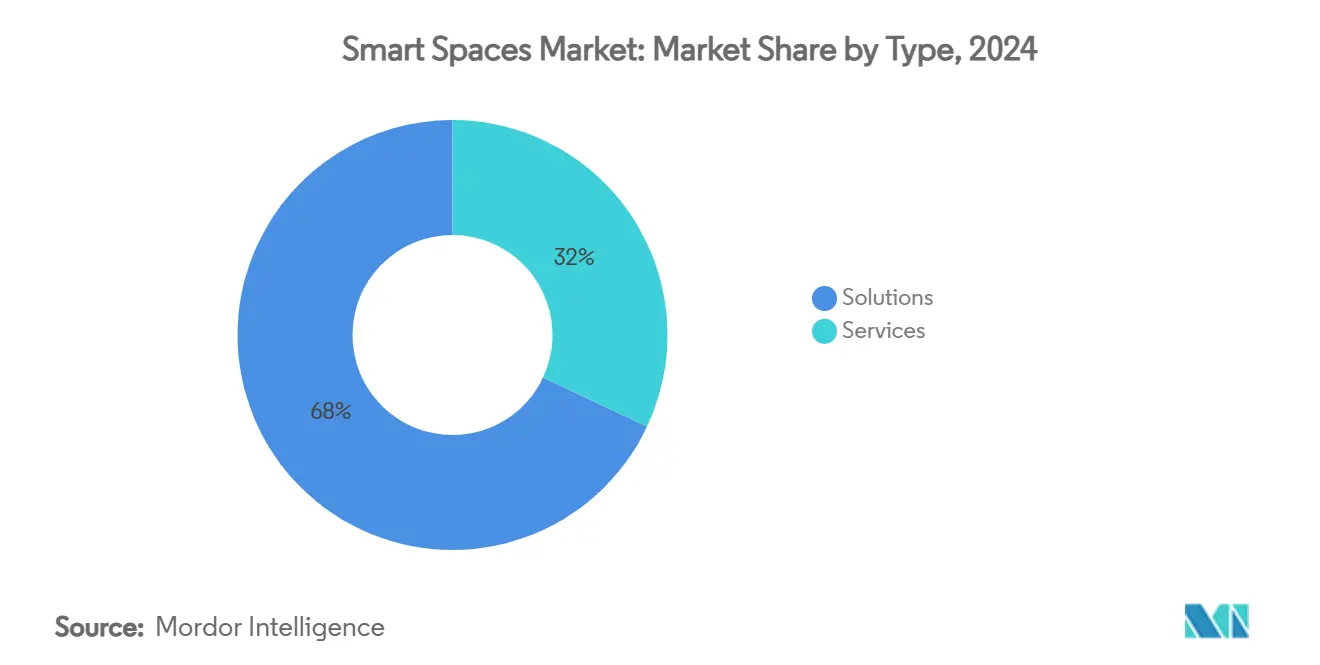
Note: Segment shares of all individual segments available upon report purchase
By End-user Industry: Residential acceleration meets commercial incumbency
Commercial real estate, healthcare, hospitality and retail collectively generated 59% of 2024 revenue, or USD 9.85 billion of the Smart space market size. Offices pursue flexible seating that demands analytics-ready occupancy data, whereas hospitals track air exchange and device uptime for infection control. Yet residential demand, especially in multi-dwelling units, is forecast to rise at a 13.75% CAGR. Logical Buildings is orchestrating a USD 110 million virtual power plant across multifamily stock to monetise demand response, demonstrating fleet-scale residential economics. SmartRent earmarked USD 10 million in December 2024 to widen landlord adoption of self-service resident portals, access control, and sub-metering. Utilities in deregulated markets offer cash incentives for smart thermostats linked to peak-shave programmes, aligning homeowner interests with grid stability. While consumer price sensitivity remains a restraint, bundled broadband plus energy packages lower acquisition friction, tilting the Smart space market toward balanced demand across sectors by 2030.
Regulators also push home energy management via mandatory sub-meters in new apartments across parts of the EU and select US states. This policy tailwind elevates residential volumes, though per-unit revenue lags commercial averages. Vendors combat margin dilution through platform multiproduct cross-sales spanning security, wellness and eldercare monitoring. As service portfolios deepen, the residential curve narrows its gap with commercial incumbents, confirming the Smart space industry’s evolution into a ubiquitous infrastructure layer.
By Application: Analytics ascend while energy management remains core
Energy Management held 34% of 2024 spending, anchoring the Smart spaces market at USD 5.68 billion. Mandatory disclosure of carbon intensity and volatile power tariffs sustains the category. Occupancy and Space Analytics, however, is pencilled in for the fastest 12.67% CAGR as hybrid-work firms seek real-time dashboards that reconcile lease costs with headcount trends. Schneider Electric’s 2025 SpaceLogic controller embeds edge AI to coordinate HVAC, lighting, and blinds, slicing energy by up to 35% in pilot sites. In parallel, grocery-chain refrigeration projects such as Hussmann’s Refrigeration IQ deploy computer vision to detect leaks before refrigerant-loss fines mount. Data-rich analytics pipelines become revenue engines themselves, with some landlords packaging anonymised utilisation trends for workplace designers. As models mature, insight outputs will integrate with enterprise planning suites, reinforcing the Smart space market’s strategic role in real-estate valuation.
Legacy categories like Security and Access Management converge toward unified credential platforms that share device identifiers with occupancy systems, improving threat resolution times. Facility Automation Integration Platforms glue disparate OEM equipment into a single semantic layer, reducing integration debt. Vendors that expose open APIs gain ecosystem gravity, whereas closed protocols risk isolation as Thread/Matter momentum compounds.
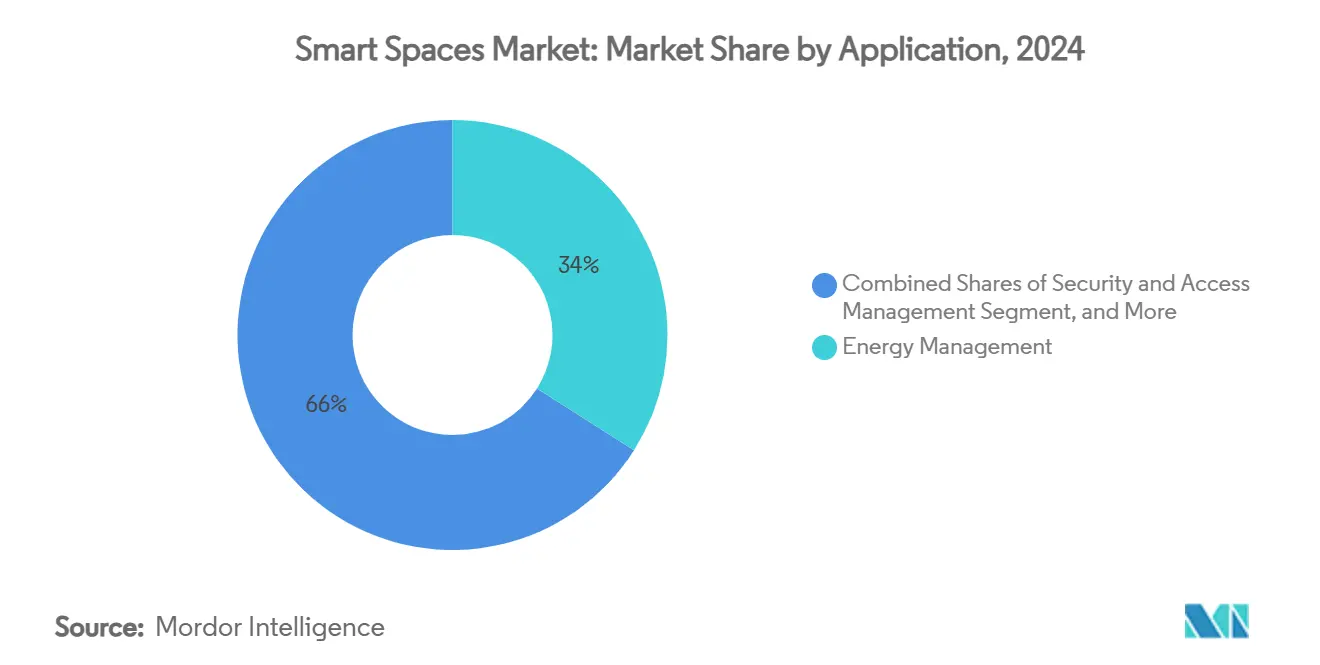
By Connectivity Technology: Thread/Matter momentum challenges Wi-Fi orthodoxy
Wi-Fi supplied 48% of 2024 link-layer revenue, courtesy of mature infrastructure and high throughput. Yet Thread/Matter is forecast to post a 13.05% CAGR through 2030 as energy-scavenging radios extend battery life and mesh topology trims gateway counts. Apple baked Thread 1.4 into tvOS 26 in 2025, while Google and Amazon prepare 2026 rollouts, legitimising the stack for commercial estates. Siemens, Enlighted, and Zumtobel now co-develop intelligent lighting that doubles as a Thread backbone, accelerating fixture-level sensor density. Bluetooth Low Energy survives for beaconing and proximity tags, whereas NB-IoT/LoRaWAN address long-range metering. Wired Ethernet with Power-over-Ethernet persists in CCTV and high-draw LED drivers. The connectivity shakeout shrinks custom gateway SKUs and simplifies commissioning, lowering total cost of ownership and broadening the Smart space market.
For emerging-market projects where Wi-Fi affordability remains decisive, multi-radio modules ensure forward compatibility. Vendors hedge by certifying identical firmware across Thread, Zigbee and Bluetooth, enhancing supply-chain flexibility. In effect, interoperability ceases to be a differentiator and becomes a prerequisite, shifting competitive focus to analytics depth and service quality.
Geography Analysis
North America contributed 37% of 2024 revenue, driven by stringent state-level energy codes and early adoption of hybrid-work analytics. California’s aggressive standards and federal tax credits support deep retrofits, while private 5G pilots in logistics parks validate latency-sensitive use cases. Honeywell recorded 8% organic growth across its building automation lines in Q1 2025, underpinned by US demand for cloud-native dashboards.[4]Honeywell, “Q1 2025 Form 10-Q,” honeywell.com Cyber-security regulation accelerates managed-service uptake as firms outsource compliance tasks to trusted vendors. Retrofit costs for ageing stock temper rollout pace, but outcome-based contracts that tie fees to measured savings unlock conservative budgets, keeping the Smart space market on a solid expansion path.
Asia Pacific is on track for a 13.53% CAGR and will increasingly tilt global volume. China allocated USD 4.5 billion to smart city pilots in its 2024 budget, stipulating that all new municipal buildings integrate digital twins. Japan’s Society 5.0 roadmap bundles smart buildings with wider robotics and mobility networks, while India’s Smart Cities Mission spans 8,000 live projects worth USD 19.67 billion. Corporate investments match the public push: Toyota’s Woven City near Mount Fuji serves as a private testbed for sensor-dense neighbourhoods. Heterogeneous regulatory landscapes complicate multinational scaling, but common motivations—urban density, energy security and ageing populations—sustain demand across the region.
Europe maintains disciplined growth on the back of climate policy. The EU’s zero-emission mandate guarantees a replacement market for inefficient controls, and GDPR ensures that privacy-by-design features carry premium pricing. Siemens committed EUR 750 million to regenerate Berlin’s Siemensstadt with digital twins, reflecting confidence in smart campus models. Middle East and Africa trail in adoption but showcase showcase megaprojects: Saudi Arabia’s Neom and the UAE’s Masdar City rely on fully digital building fabrics, serving as regional proof points. Budget volatility and political risk keep deployment skewed to government-backed ventures, yet demonstrable returns draw private co-investors over time, widening the addressable Smart spaces market.
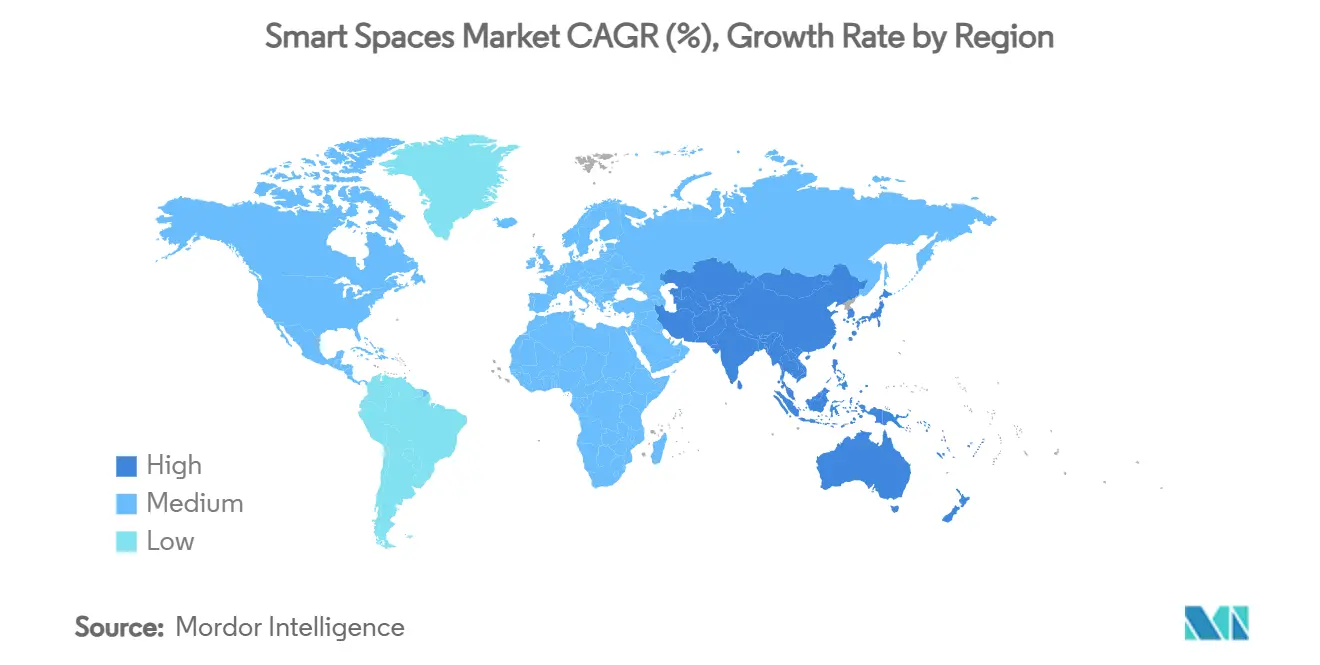
Competitive Landscape
The competitive field is moderately fragmented. A cohort of diversified conglomerates—Honeywell, Siemens, Johnson Controls, ABB, and Schneider—leverages large installed bases to cross-sell analytics subscriptions. Each is bulking up through targeted M&A: Honeywell finalised the USD 4.95 billion purchase of Carrier’s Global Access Solutions in June 2024, folding credential management into its Forge stack. Trane acquired BrainBox AI in December 2024, gaining autonomous HVAC controls and a 14,000-site footprint for data harvesting. Market disruptors include software-first firms such as ThoughtWire and Spacewell that pitch vendor-agnostic digital twins, competing on deployment speed rather than hardware breadth.
Interoperability standards de-risk smaller entrants. Thread 1.4 and Matter certification levels the connectivity playing field, allowing sensor start-ups to sell into large enterprises without proprietary gateways. Private 5G creates a new value chain where telecom operators and edge-infra specialists like Nokia and HPE GreenLake vie to host building automation workloads. Patent filings emphasise semantic data models that simplify multi-system orchestration, indicating the next battleground is contextual data not device count.
Price competition is muted because buyers prioritise proven savings and regulatory compliance over lowest capex. Vendors differentiate with AI credibility: Johnson Controls markets generative AI planning tools inside OpenBlue, while Bosch earmarked EUR 2.5 billion for AI agents that learn behavioural patterns to pre-empt maintenance. System integrators such as Accenture and Infosys play orchestration roles but do not control device roadmaps, positioning hardware-software hybrids to capture the lion’s share of future Smart space market expansion.
Smart Spaces Industry Leaders
-
ABB Ltd
-
Siemens AG
-
Adappt Intelligence Inc.
-
Spacewell Faseas
-
Cisco Systems Inc.
- *Disclaimer: Major Players sorted in no particular order
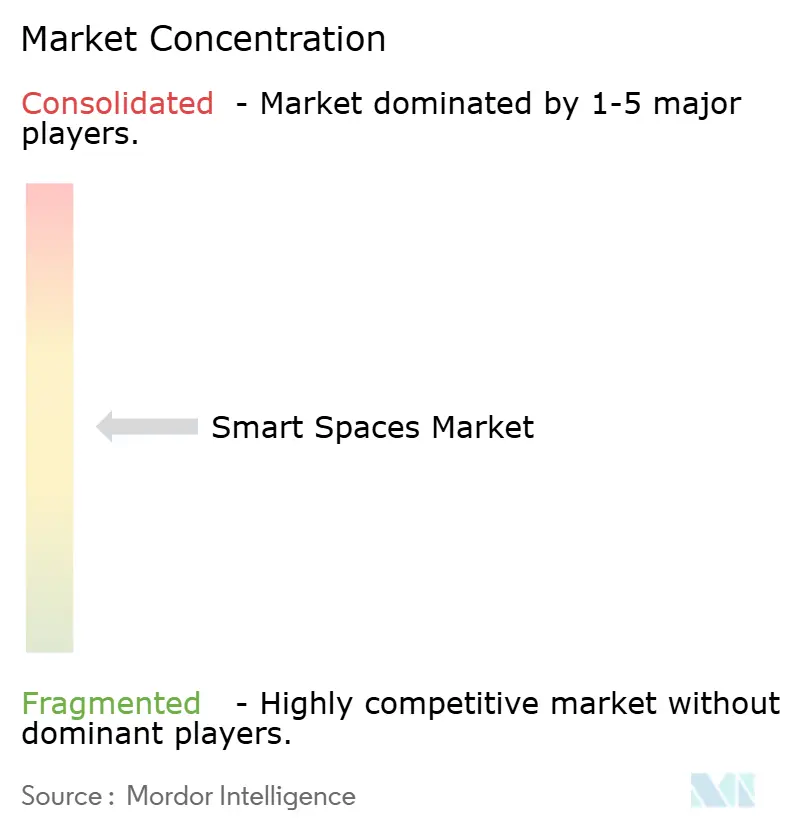


Recent Industry Developments
- February 2025: ABB and Samsung Electronics linked ABB InSite with SmartThings Pro to extend home-to-commercial energy optimisation.
- January 2025: Bosch announced EUR 2.5 billion investment in AI agents for smart building automation through 2027.
- December 2024: Trane Technologies completed the acquisition of BrainBox AI for autonomous HVAC control.
- December 2024: SmartRent launched a USD 10 million programme to accelerate multifamily smart-space innovation.
Global Smart Spaces Market Report Scope
Smart space is a physical environment deployed with technologies, such as monitors and sensors, which allow humans to interact with the technology-enabled systems.
| Solutions | Software Platforms |
| Hardware and Edge Devices | |
| Services | Professional Services |
| Managed Services |
| Commercial | Offices and Co-working Spaces |
| Retail and Malls | |
| Healthcare Facilities | |
| Hospitality and Leisure | |
| Residential | Single-family Homes |
| Multi-dwelling Units |
| Energy Management |
| Occupancy and Space Analytics |
| Lighting and HVAC Control |
| Security and Access Management |
| Facility Automation Integration Platforms |
| Wi-Fi |
| Bluetooth Low Energy (BLE) |
| Zigbee |
| Thread / Matter |
| Z-Wave |
| NB-IoT and LoRaWAN |
| Wired (Ethernet / PoE) |
| North America | United States | |
| Canada | ||
| Mexico | ||
| South America | Argentina | |
| Brazil | ||
| Rest of South America | ||
| Europe | United Kingdom | |
| France | ||
| Germany | ||
| Rest of Europe | ||
| Asia Pacific | China | |
| Japan | ||
| India | ||
| South Korea | ||
| Rest of Asia Pacific | ||
| Middle East and Africa | Middle East | Saudi Arabia |
| United Arab Emirates | ||
| Turkey | ||
| Rest of Middle East | ||
| Africa | Nigeria | |
| South Africa | ||
| Rest of Africa | ||
| By Type | Solutions | Software Platforms | |
| Hardware and Edge Devices | |||
| Services | Professional Services | ||
| Managed Services | |||
| By End-user Industry | Commercial | Offices and Co-working Spaces | |
| Retail and Malls | |||
| Healthcare Facilities | |||
| Hospitality and Leisure | |||
| Residential | Single-family Homes | ||
| Multi-dwelling Units | |||
| By Application | Energy Management | ||
| Occupancy and Space Analytics | |||
| Lighting and HVAC Control | |||
| Security and Access Management | |||
| Facility Automation Integration Platforms | |||
| By Connectivity Technology | Wi-Fi | ||
| Bluetooth Low Energy (BLE) | |||
| Zigbee | |||
| Thread / Matter | |||
| Z-Wave | |||
| NB-IoT and LoRaWAN | |||
| Wired (Ethernet / PoE) | |||
| By Geography | North America | United States | |
| Canada | |||
| Mexico | |||
| South America | Argentina | ||
| Brazil | |||
| Rest of South America | |||
| Europe | United Kingdom | ||
| France | |||
| Germany | |||
| Rest of Europe | |||
| Asia Pacific | China | ||
| Japan | |||
| India | |||
| South Korea | |||
| Rest of Asia Pacific | |||
| Middle East and Africa | Middle East | Saudi Arabia | |
| United Arab Emirates | |||
| Turkey | |||
| Rest of Middle East | |||
| Africa | Nigeria | ||
| South Africa | |||
| Rest of Africa | |||


Key Questions Answered in the Report
What is the current size of the Smart space market?
The Smart space market size reached USD 16.70 billion in 2025 and is projected to hit USD 29.46 billion by 2030.
Which segment is expanding fastest?
Services are forecast to post the highest 13.87% CAGR as enterprises shift from capital purchases to managed optimisation contracts.
How large is the Smart space market share of North America
North America accounted for 37% of 2024 revenue, the largest regional share in the industry.
Why are Thread and Matter standards important?
They enable devices from different manufacturers to interoperate without custom gateways, lowering integration costs and accelerating deployment.
What role does private 5G play in smart buildings?
Private 5G delivers low-latency, interference-free connectivity that supports mission-critical applications such as autonomous HVAC control and high-resolution video analytics.
Which application area leads spending today?
Energy Management holds the top spot with 34% of 2024 revenue, reflecting the direct financial returns of reducing electricity and heating costs.
Page last updated on:
